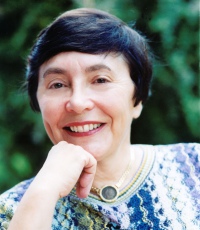About

Nancy C. Andreasen
Nancy C. Andreasen WF ’58, National Medalist of Science; Andrew H. Woods Chair of Psychiatry, University of Iowa, Carver College of Medicine
“Where We Have Been and Where We Are Going”: Nancy Andreasen’s career spans Renaissance literature, psychiatry, neuroscience
“How does the brain think?”
It’s not an obvious question for the author of John Donne, Conservative Revolutionary to ask. And, when Nancy Andreasen WF ’58 asked it in the late 1960s, not even her neuroanatomy professor in a respected medical college could answer it.
“The professor looked at me as if I had flown in from outer space,” she writes in her 2005 book The Creating Brain: The Neuroscience of Genius, “repeated my question in a mocking tone, and made facial and body gestures indicating that I had asked the most stupid question in the world. Many members of our nearly all-male class guffawed in sympathy with his reaction…Only later did I realize his response was one of self-defense. I had asked a question to which the omniscient professor could not even approximate an answer.”
For her efforts to find answers, Nancy Andreasen received a National Medal of Science in 2000, one of many honors in her multifaceted career. The Andrew H. Woods Chair of Psychiatry at the University of Iowa’s Carver College of Medicine, former 13-year editor of The American Journal of Psychiatry, and an internationally renowned expert on schizophrenia, she has studied brain functions underlying various mental illnesses, as well as processes like creativity and memory.
Though a pioneering neuroscientist and psychiatrist, Dr. Andreasen still considers her early work in the humanities central to her career. Following her doctoral studies in Renaissance literature at Nebraska, Oxford, and Harvard, Dr. Andreasen became a popular young professor in the University of Iowa’s English department.
The experience, she says today, not only honed her teaching and writing in ways that have enabled her to reach large audiences throughout her career, but also gave her an unmatched sense of context for her scientific work. “I always bridged English, history, and philosophy,” she says, “and so I can bring to science a sense of how our place in time relates to our past and future. Some scientists think about what experiments they should do today but are almost clueless about where we might be in five or ten years. I always find myself asking where we have been and where we are going, and using large conceptual structures rather than fine-grained ones. That comes from the humanities.”
Despite her early achievements as a literary scholar, serious complications during her first pregnancy led Dr. Andreasen to rethink her career. “I knew if this [illness] had happened to me … 100 years earlier, I probably would’ve been dead,” she told the PBS show Closer to Truth in 2006. “I … got my first book on John Donne accepted for publication, and instead of feeling elated, I felt kind of discouraged. … I said to myself, if I had taken the same amount of effort that I put into writing that book, and applied it in a field like medicine, I might actually produce something. So I decided to go to medical school and to have a career in research.” She attended Iowa’s medical school and, M.D. in hand, joined its psychiatry faculty.
Colleagues in her new field, however, were not quick to see the value of Dr. Andreasen’s previous work. Her new department chair, she recalls, “must’ve told me fifty times, ‘If your Ph.D. were in biochemistry you could take pride in it, but in English, it’s worth nothing.’ I decided to prove him wrong, so early on I made a name for myself by studying language abnormalities in schizophrenia”—now landmark studies.
These exchanges also spurred Dr. Andreasen to probe traditional wisdom about connections between creativity, genius, and mental illness, a subject that had intrigued her for some time. The resulting papers from the mid-1970s, like her work on language in schizophrenia, have become classics. Dr. Andreasen studied the mental health histories of 30 writers, expecting a strong correlation between literary creativity and schizophrenia. She found, in fact, no personal or familial indication of schizophrenia, but a significant incidence of depression, bipolar disorder, and other mood disorders.
Today, as she explains in The Creating Brain (2005), Dr. Andreasen is revisiting the subject, examining creativity among both writers and scientists. (“If I could find funding,” she adds, “I’d do business leaders too.”) Writers and artists, she expects, will be less likely to show the disjointed association of schizophrenia, which would disrupt the sustained attention their work requires, and more likely to mirror the kinds of associations found in mood disorders—sensitivity to sensory stimuli, for instance, or perfectionism. On the other hand, mathematicians and scientists, whose creativity stems from flashes of insight, might have a higher incidence of schizophrenia, with its radically unexpected associations. In both groups, however, she expects that regions of the brain involved in creating associations between previously unconnected ideas would be unusually active. “Creativity at its heart is a basic approach to perceiving the world and solving problems,” says Dr. Andreasen. “Whether in the arts or in the sciences depends somewhat on the ways you got encouraged and what you got exposed to. Artists and scientists have much more in common than they realize.”
So far, she says, advanced neuroimaging supports her surmise: Both the writers and the scientists show greater and different associative activation than the control groups. As she adds subjects, she will learn more about their histories of mood disorder and schizophrenia. “This is one of the most fun studies I’ve done,” she says, “because these people are all so interesting—kind of like assembling all of your Woodrow Wilson Fellows and interviewing them.”
Dr. Andreasen and her multidisciplinary research group have pioneered the use of neuroimaging in studying not only creativity but also mental illness. In the mid-1980s she published the first study of schizophrenia to rely on magnetic resonance imaging (MRI) scans, and has since led the development of a sophisticated neuroimaging software package, BRAINS (Brain Research: Analysis of Images, Networks, and Systems). These new tools have allowed Dr. Andreasen’s team to demonstrate, for example, the ways in which schizophrenia—long thought of primarily as a thought disorder, limited to the cerebral cortex—involves the thalamus and cerebellum, which affect cognitive processing of sensory input.
Such work has kept Dr. Andreasen in the vanguard of “the biological revolution in psychiatry”—the subtitle of her 1984 bestseller, The Broken Brain. “That first big change was the movement of psychiatry from thinking of psychoanalysis as its foundation,” she says, “to realizing that neuroscience is its basic intellectual foundation.”
The latest front in the revolution, which she explored in Brave New Brain (2001): the integration of neuroimaging and genomics. Coupling BRAINS with genetic analysis, Dr. Andreasen’s team is working to associate specific genes with mental illnesses. The next revolution will come, she says, “when we can take this combined work of genomics and imaging, and the molecular mechanisms of mental illnesses, and use that information to build better treatments.”
Beyond her pioneering work in neuroscience, Dr. Andreasen has also blazed trails for women scholars, serving on many panels on gender issues in the academy. Because there were very few women M.D.s in the Institute of Medicine when she was elected, she says, “Every year thereafter I’ve nominated a woman.”
It’s a deeply personal commitment: Although she won a full scholarship to Harvard at 16, her parents insisted she should stay in Nebraska, get married, and teach kindergarten or grade school. She remembers how, as a senior at the University of Nebraska, “I just so desperately wanted to go to grad school. Getting the Woodrow Wilson made it absolutely possible for me to move into a career as a university professor.
“The Fellowship set me on a path that I’ve been on ever since. The real goal of my life has been to help humanity in some way—whether as a teacher, my first intent, or by making breakthroughs in science, my second intent. We get given gifts, and we’re obligated to use them and share them with other people.”

